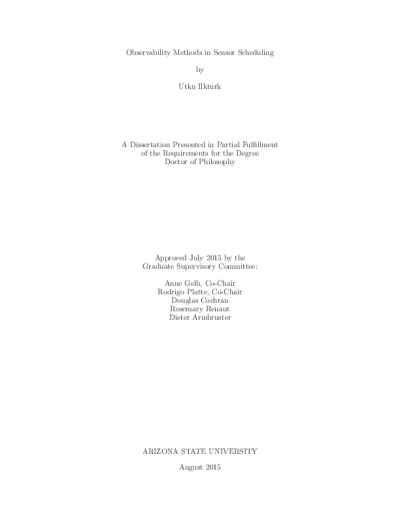The Pauli-Lubanski Vector in a Group-Theoretical Approach to Relativistic Wave Equations

Description
Chapter 1 introduces some key elements of important topics such as; quantum mechanics,
representation theory of the Lorentz and Poincare groups, and a review of some basic rela- ´
tivistic wave equations that will play an important role in the work to follow. In Chapter 2,
a complex covariant form of the classical Maxwell’s equations in a moving medium or at
rest is introduced. In addition, a compact, Lorentz invariant, form of the energy-momentum
tensor is derived. In chapter 3, the concept of photon helicity is critically analyzed and its
connection with the Pauli-Lubanski vector from the viewpoint of the complex electromag- ´
netic field, E+ iH. To this end, a complex covariant form of Maxwell’s equations is used.
Chapter 4 analyzes basic relativistic wave equations for the classical fields, such as Dirac’s
equation, Weyl’s two-component equation for massless neutrinos and the Proca, Maxwell
and Fierz-Pauli equations, from the viewpoint of the Pauli-Lubanski vector and the Casimir ´
operators of the Poincare group. A connection between the spin of a particle/field and ´
consistency of the corresponding overdetermined system is emphasized in the massless
case. Chapter 5 focuses on the so-called generalized quantum harmonic oscillator, which
is a Schrodinger equation with a time-varying quadratic Hamiltonian operator. The time ¨
evolution of exact wave functions of the generalized harmonic oscillators is determined
in terms of the solutions of certain Ermakov and Riccati-type systems. In addition, it is
shown that the classical Arnold transform is naturally connected with Ehrenfest’s theorem
for generalized harmonic oscillators. In Chapter 6, as an example of the usefulness of the
methods introduced in Chapter 5 a model for the quantization of an electromagnetic field
in a variable media is analyzed. The concept of quantization of an electromagnetic field
in factorizable media is discussed via the Caldirola-Kanai Hamiltonian. A single mode
of radiation for this model is used to find time-dependent photon amplitudes in relation
to Fock states. A multi-parameter family of the squeezed states, photon statistics, and the
uncertainty relation, are explicitly given in terms of the Ermakov-type system.
representation theory of the Lorentz and Poincare groups, and a review of some basic rela- ´
tivistic wave equations that will play an important role in the work to follow. In Chapter 2,
a complex covariant form of the classical Maxwell’s equations in a moving medium or at
rest is introduced. In addition, a compact, Lorentz invariant, form of the energy-momentum
tensor is derived. In chapter 3, the concept of photon helicity is critically analyzed and its
connection with the Pauli-Lubanski vector from the viewpoint of the complex electromag- ´
netic field, E+ iH. To this end, a complex covariant form of Maxwell’s equations is used.
Chapter 4 analyzes basic relativistic wave equations for the classical fields, such as Dirac’s
equation, Weyl’s two-component equation for massless neutrinos and the Proca, Maxwell
and Fierz-Pauli equations, from the viewpoint of the Pauli-Lubanski vector and the Casimir ´
operators of the Poincare group. A connection between the spin of a particle/field and ´
consistency of the corresponding overdetermined system is emphasized in the massless
case. Chapter 5 focuses on the so-called generalized quantum harmonic oscillator, which
is a Schrodinger equation with a time-varying quadratic Hamiltonian operator. The time ¨
evolution of exact wave functions of the generalized harmonic oscillators is determined
in terms of the solutions of certain Ermakov and Riccati-type systems. In addition, it is
shown that the classical Arnold transform is naturally connected with Ehrenfest’s theorem
for generalized harmonic oscillators. In Chapter 6, as an example of the usefulness of the
methods introduced in Chapter 5 a model for the quantization of an electromagnetic field
in a variable media is analyzed. The concept of quantization of an electromagnetic field
in factorizable media is discussed via the Caldirola-Kanai Hamiltonian. A single mode
of radiation for this model is used to find time-dependent photon amplitudes in relation
to Fock states. A multi-parameter family of the squeezed states, photon statistics, and the
uncertainty relation, are explicitly given in terms of the Ermakov-type system.
Date Created
The date the item was original created (prior to any relationship with the ASU Digital Repositories.)
2016
Agent
- Author (aut): Lanfear, Nathan A
- Thesis advisor (ths): Suslov, Sergei
- Thesis advisor (ths): Kotschwar, Brett
- Committee member: Platte, Rodrigo
- Committee member: Matyushov, Dmitry
- Committee member: Kuiper, Hendrik
- Committee member: Gardner, Carl
- Publisher (pbl): Arizona State University








